
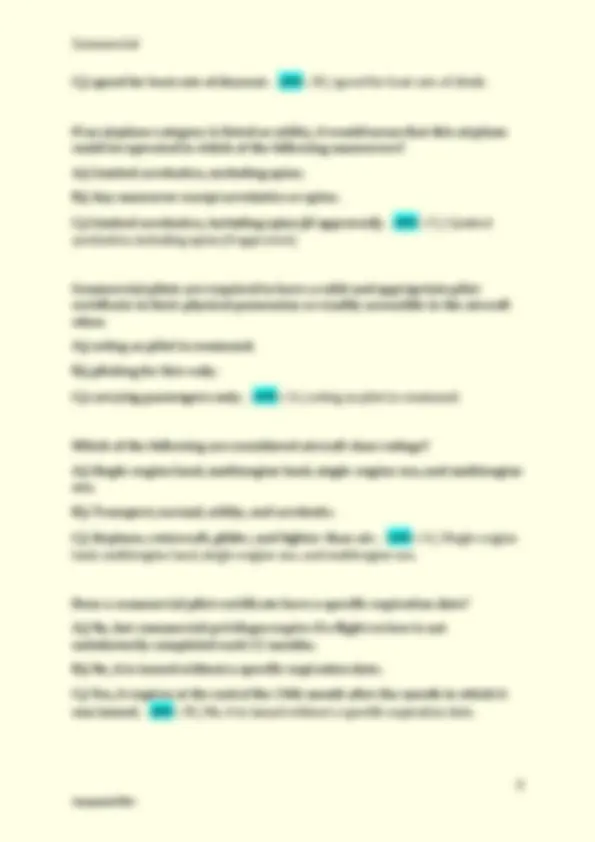
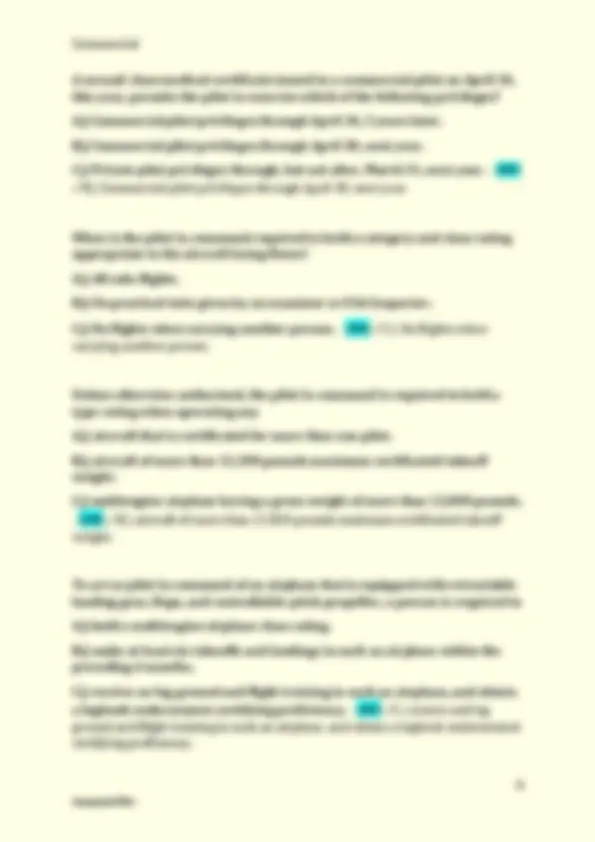
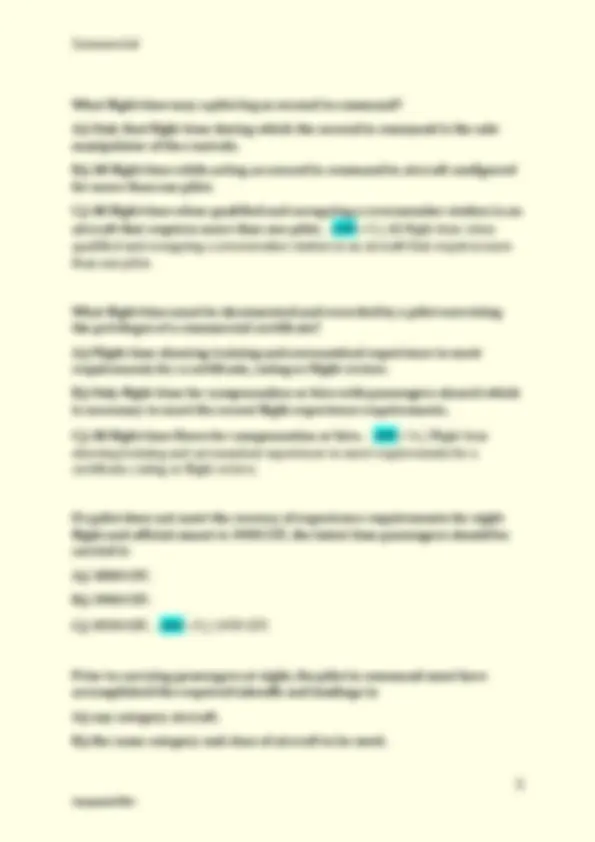
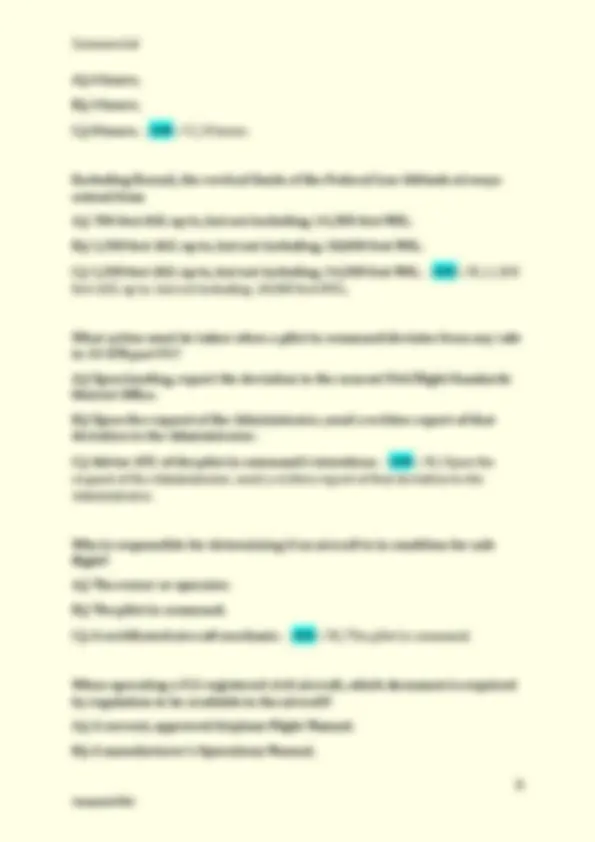
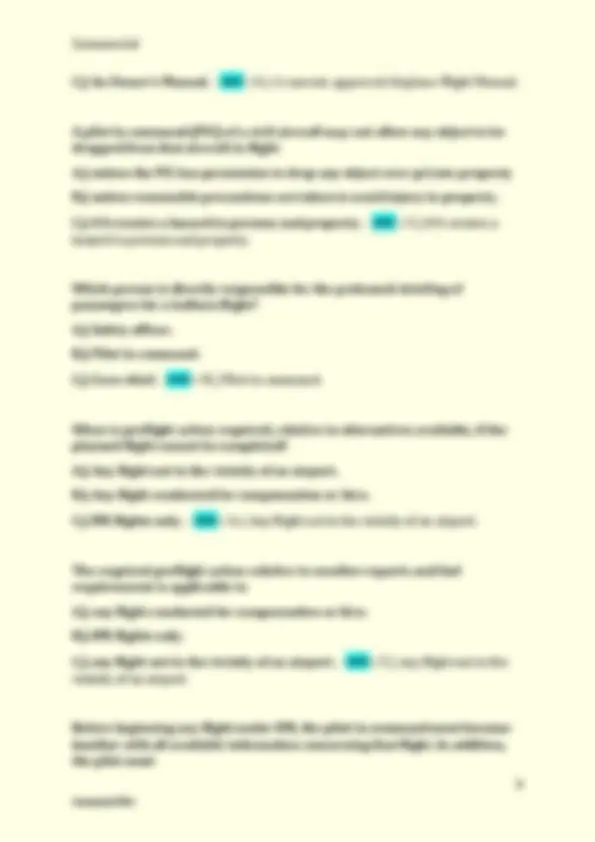
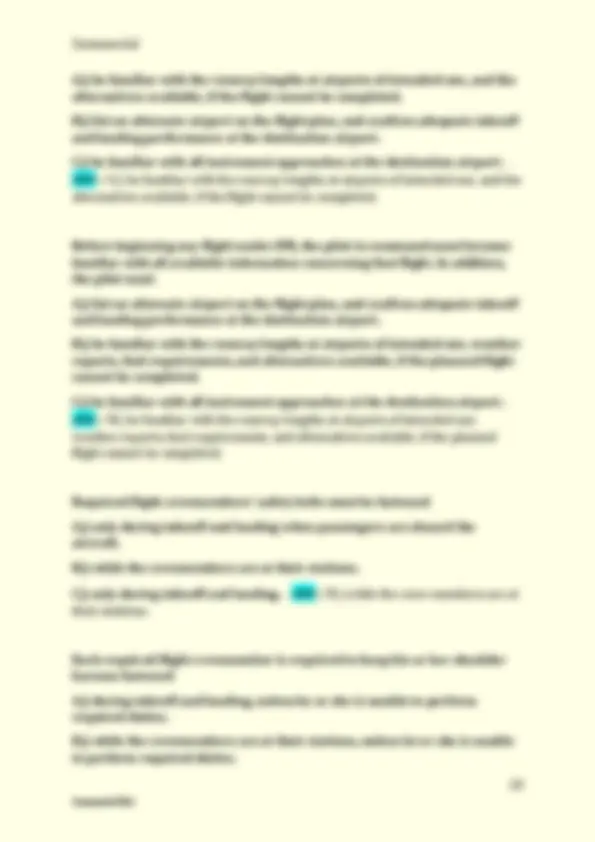
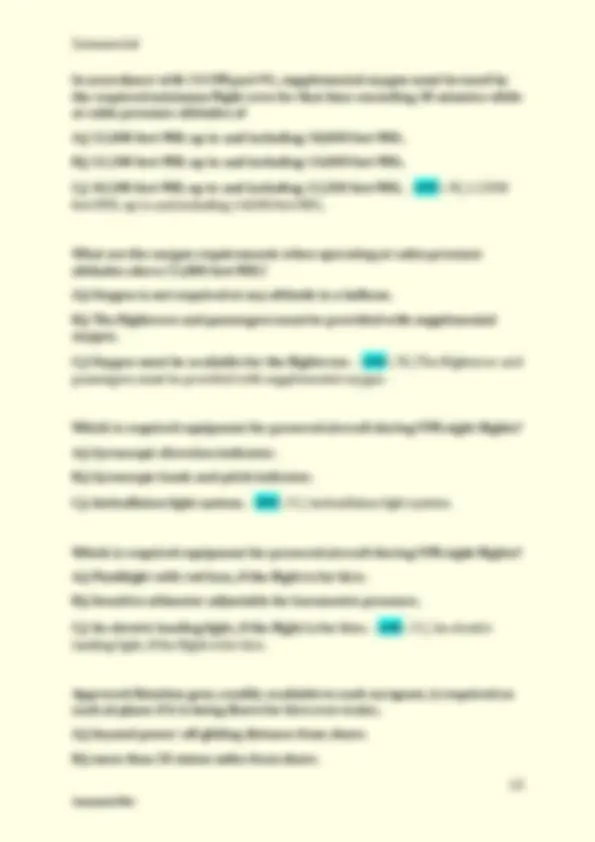
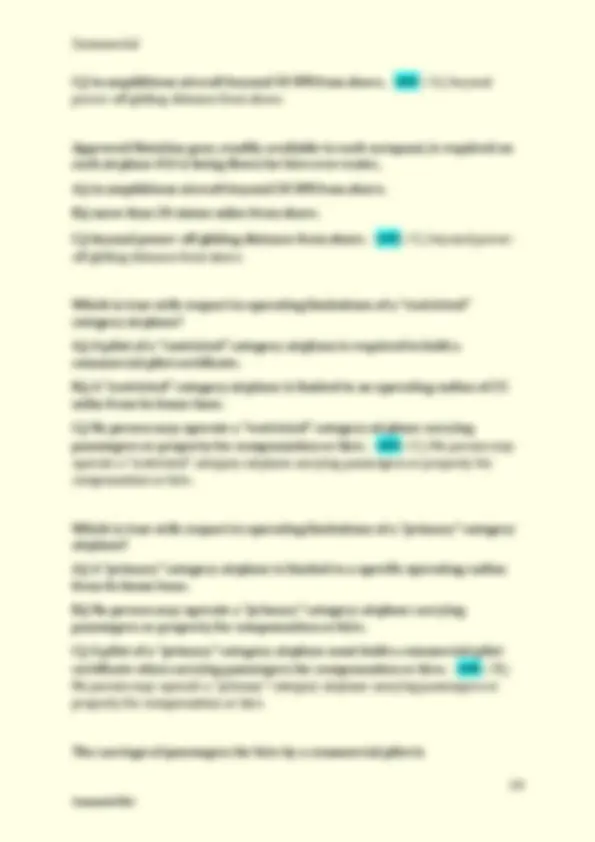
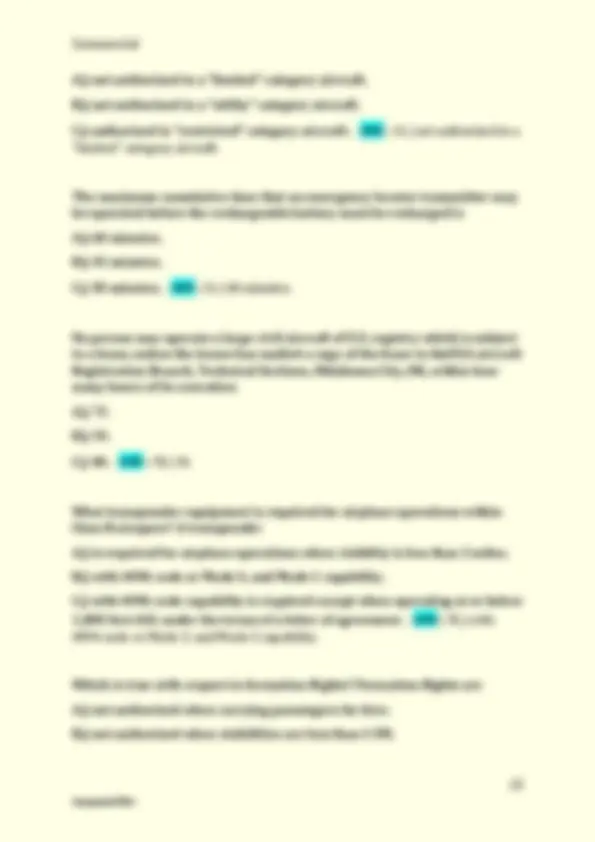
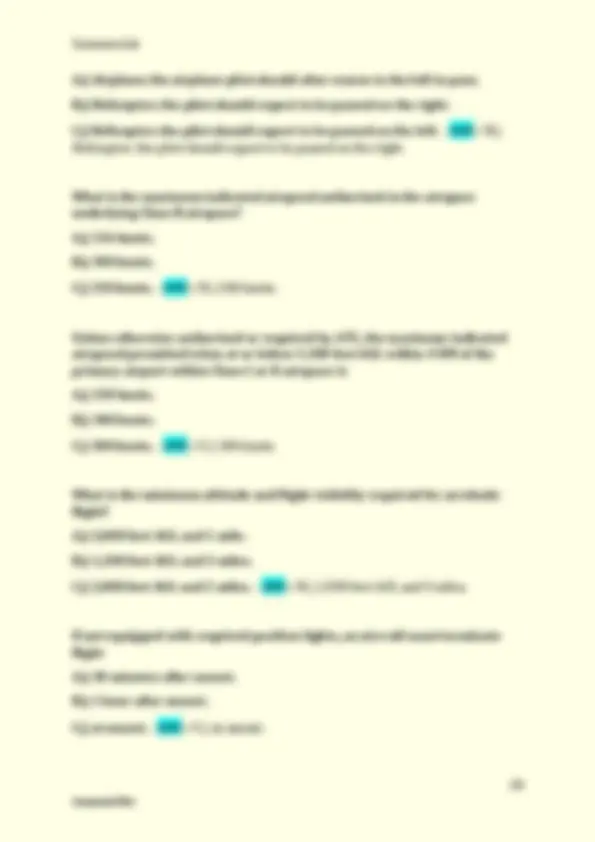
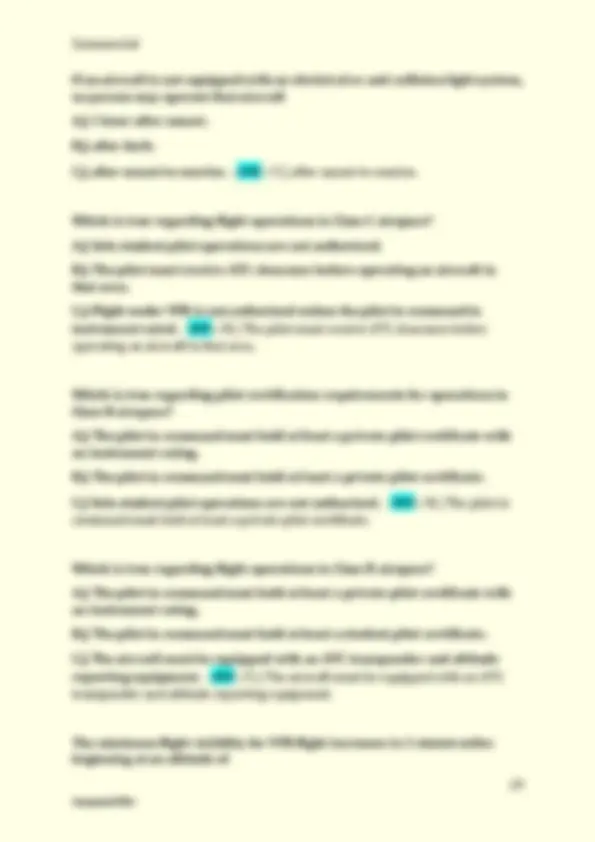
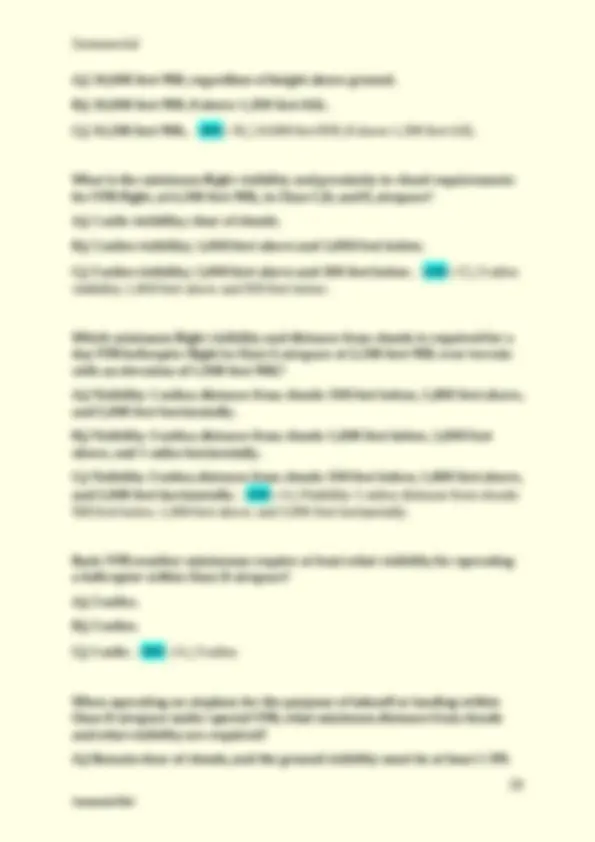
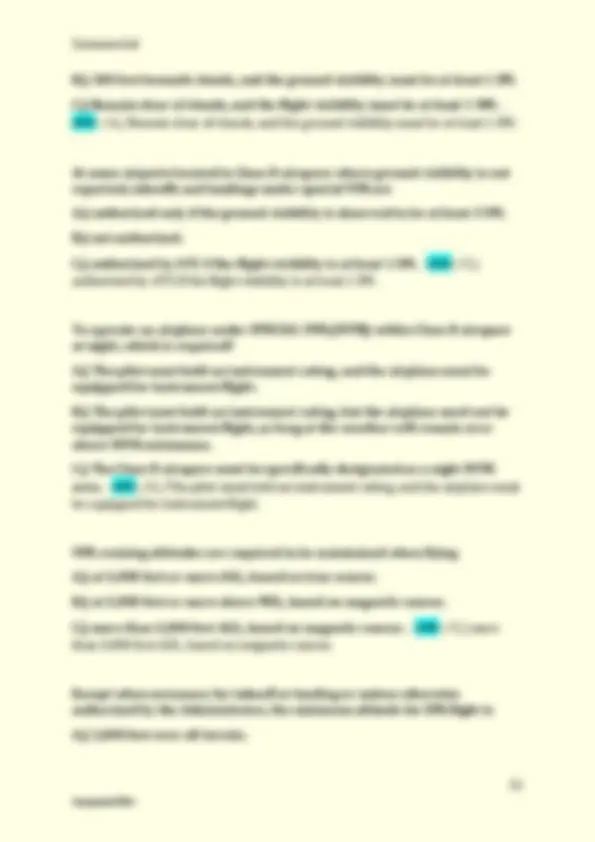

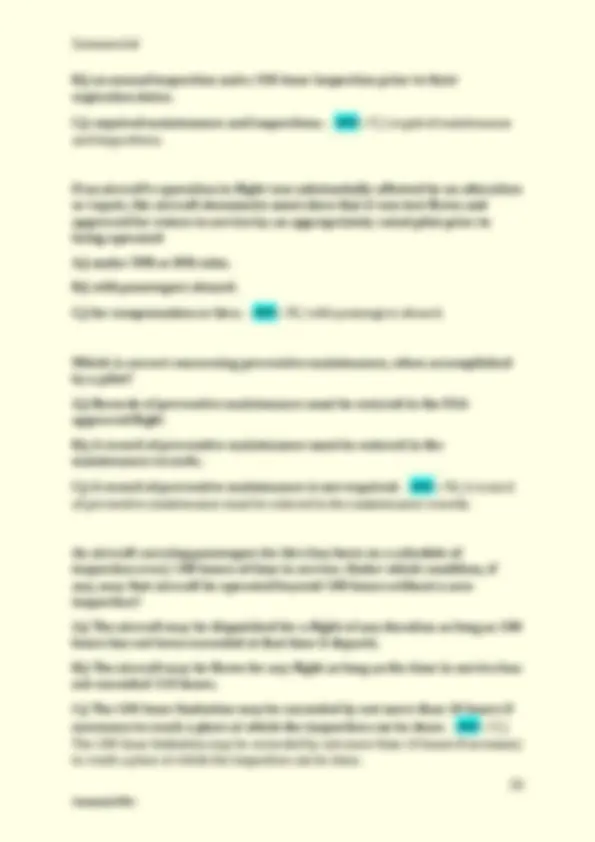
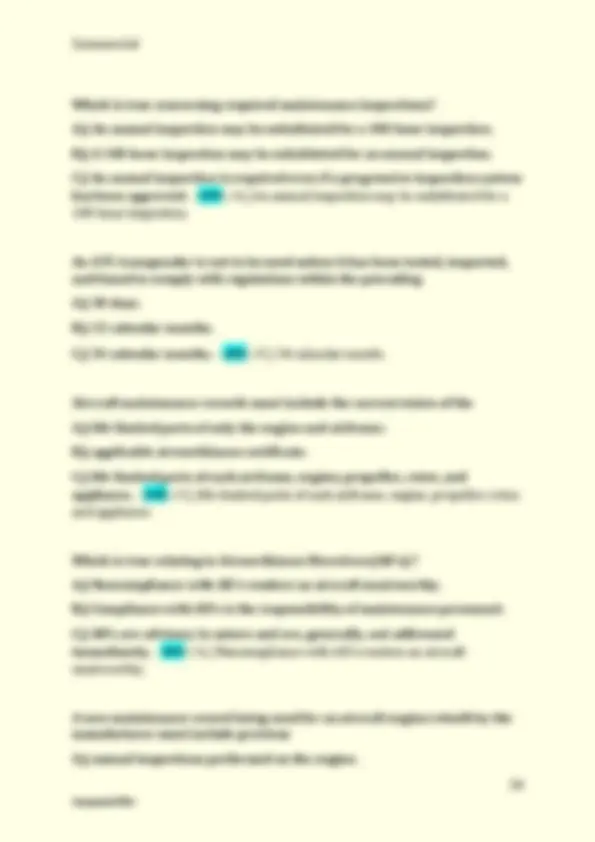
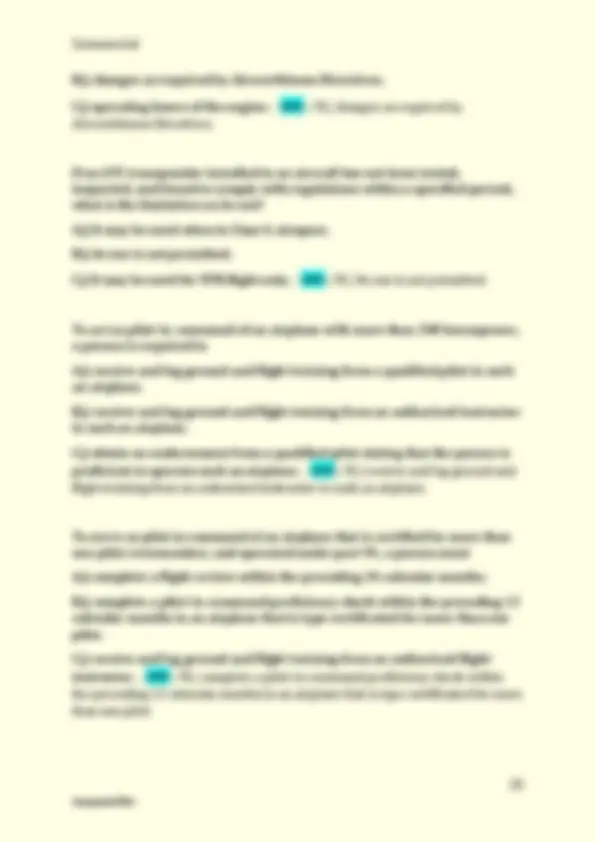
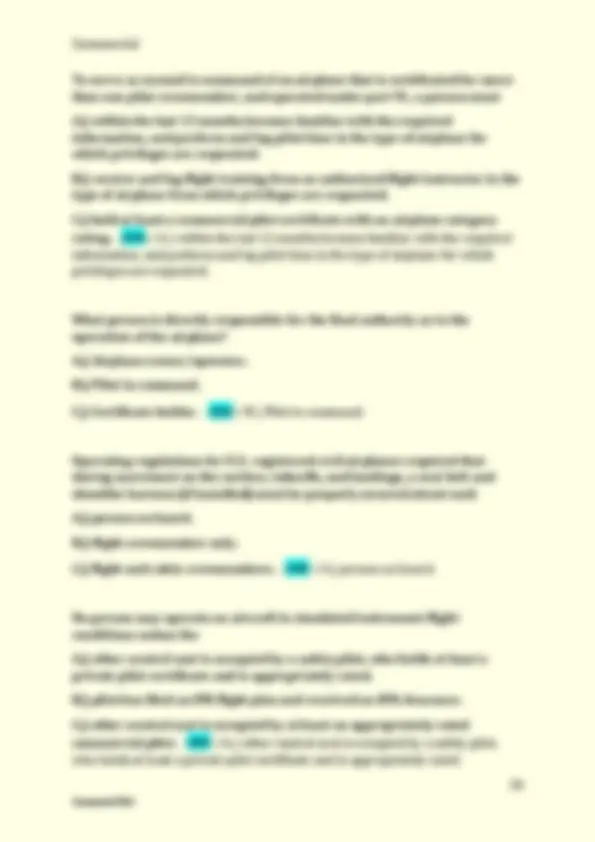
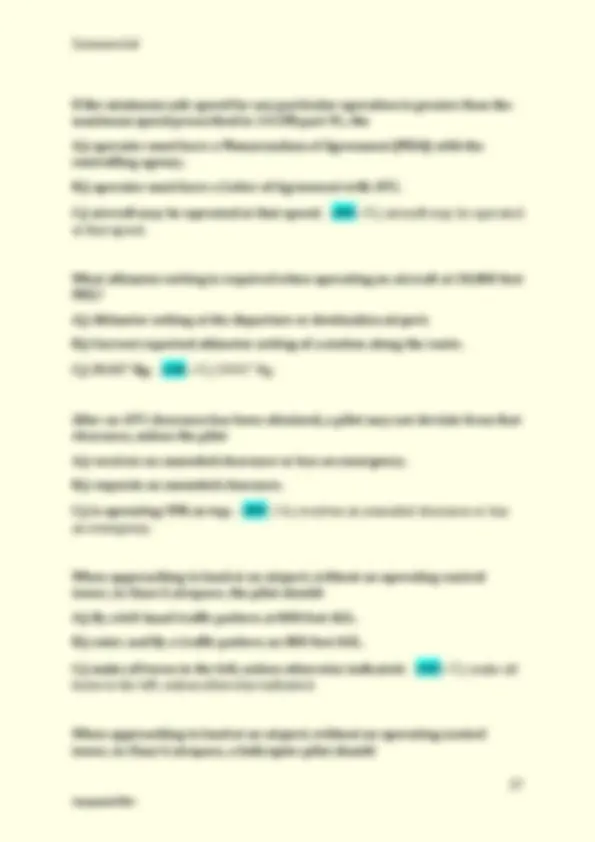
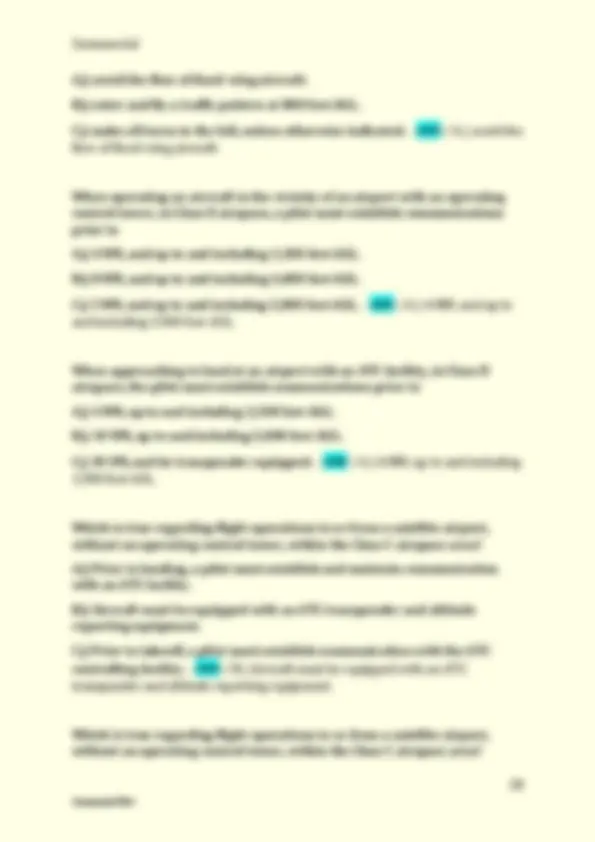
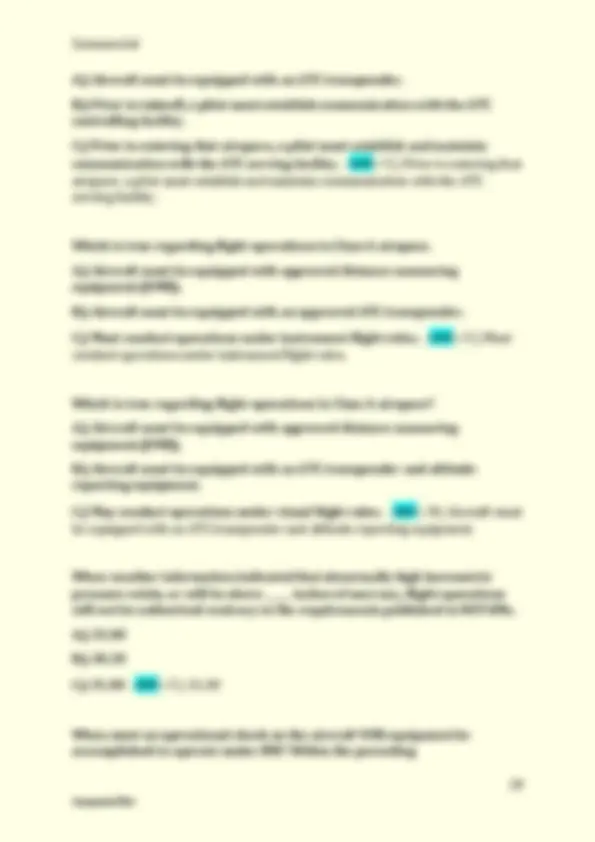

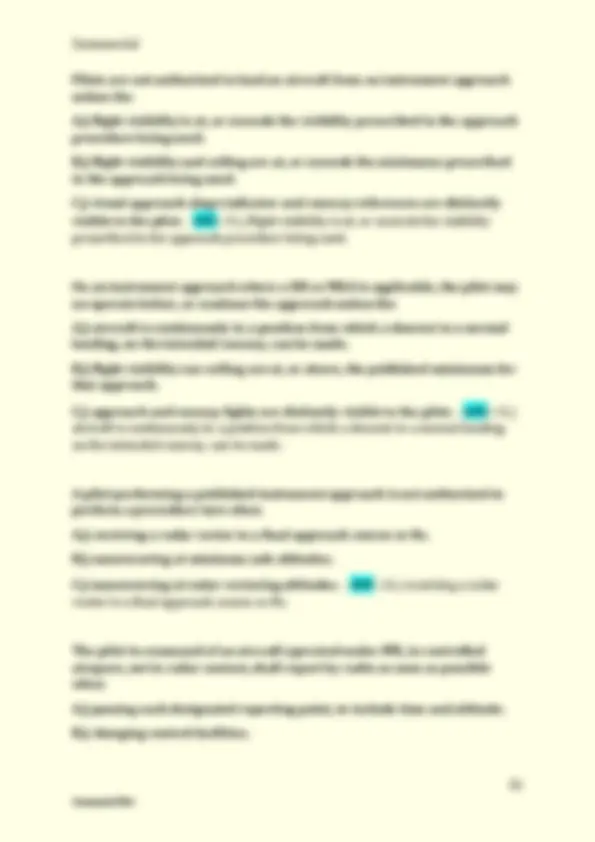
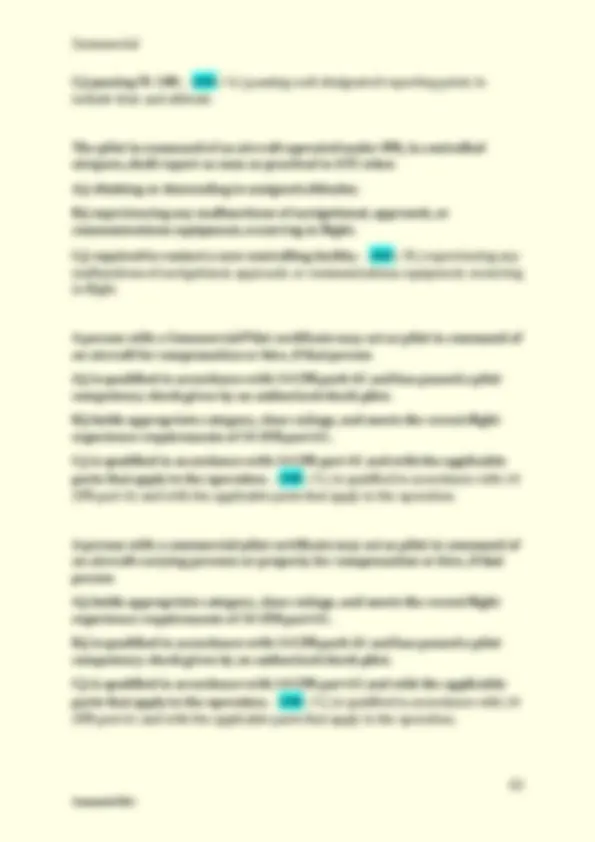

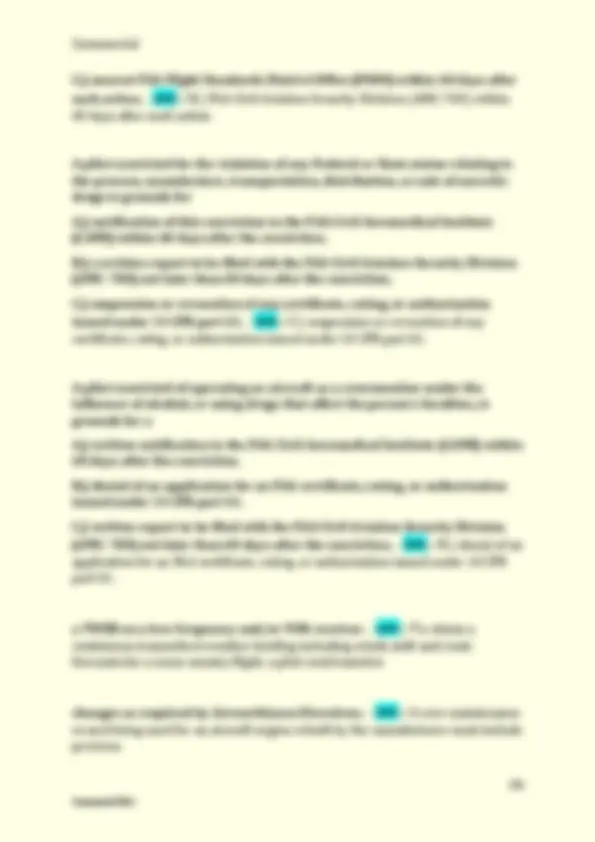
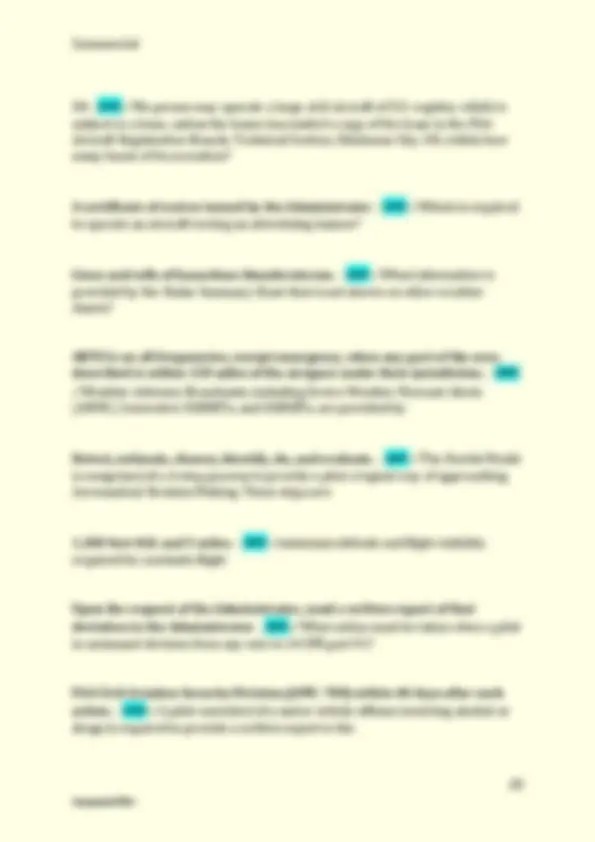
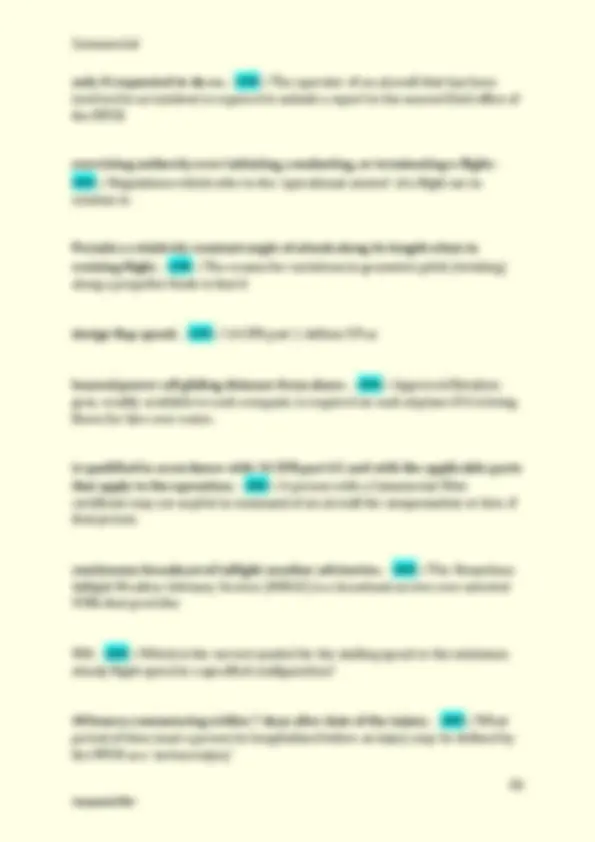
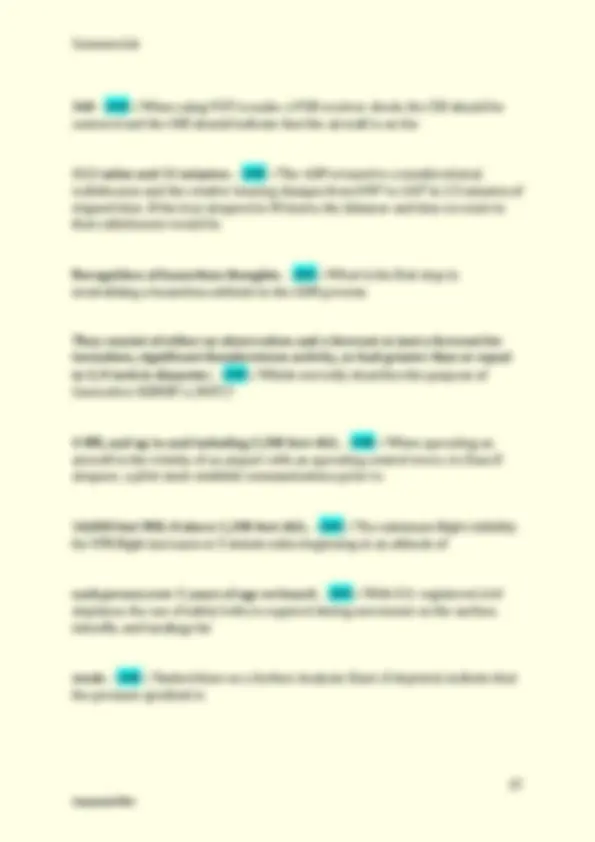
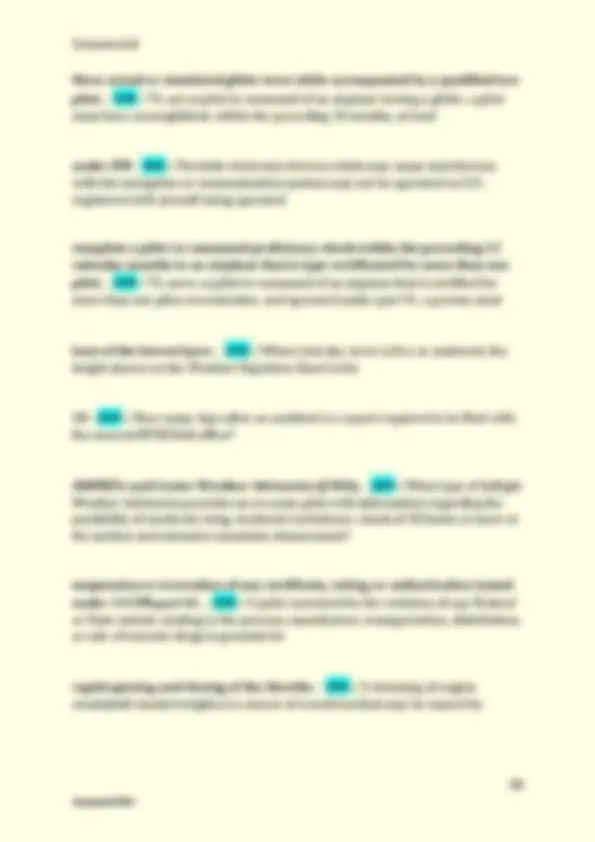
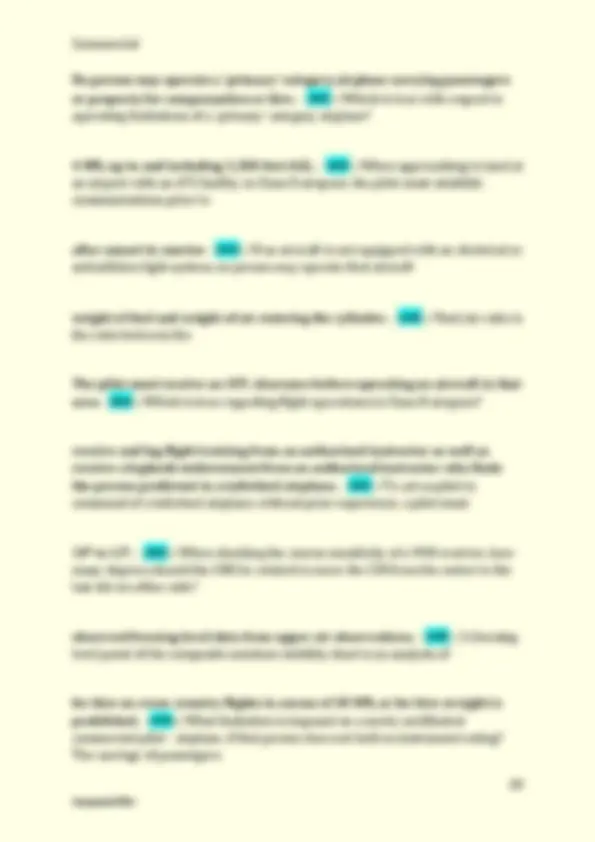
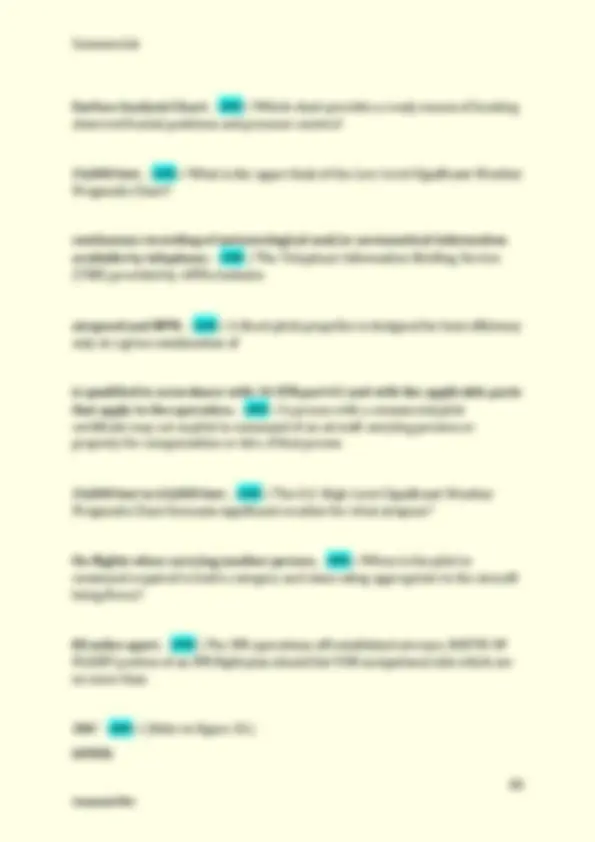
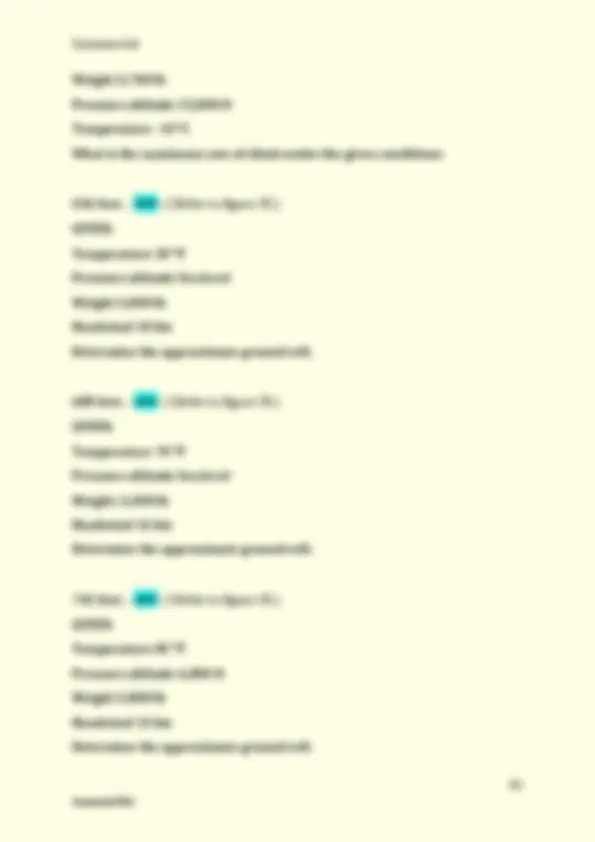
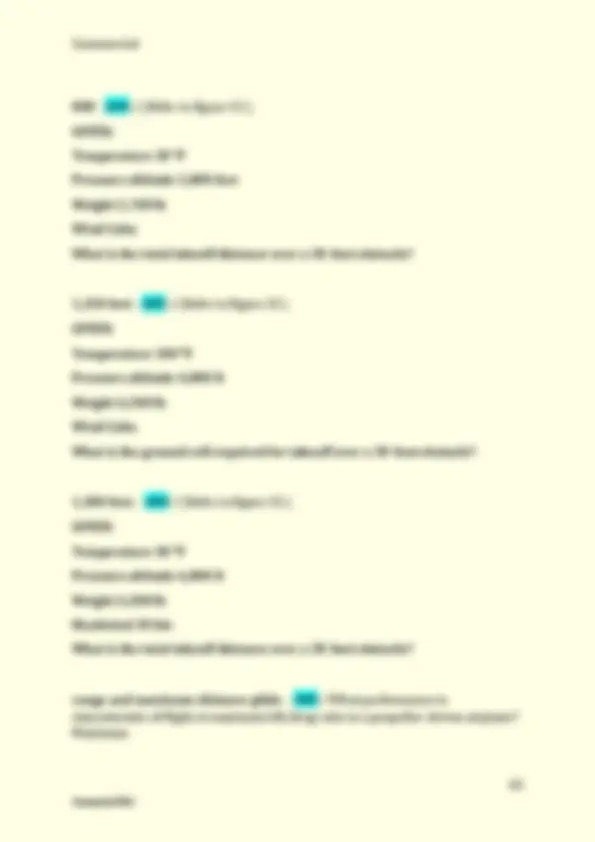
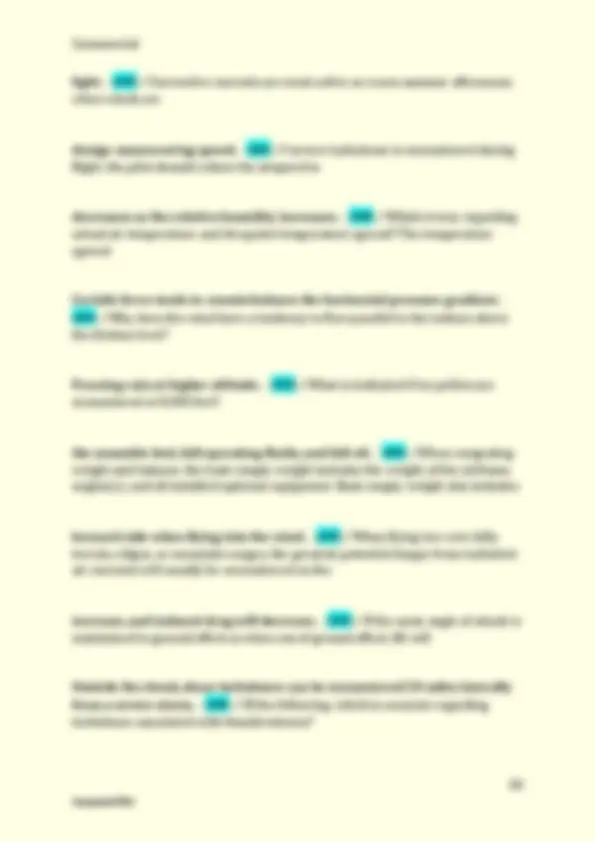
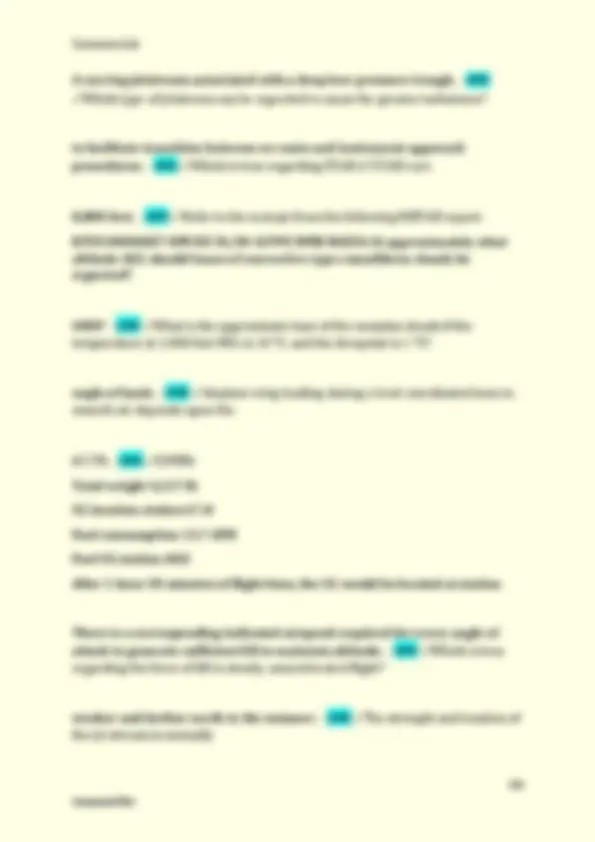
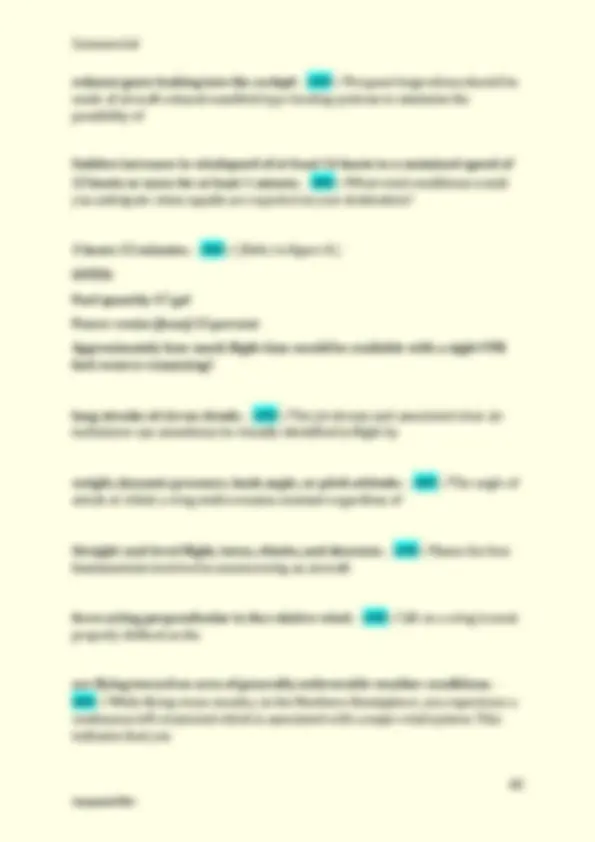
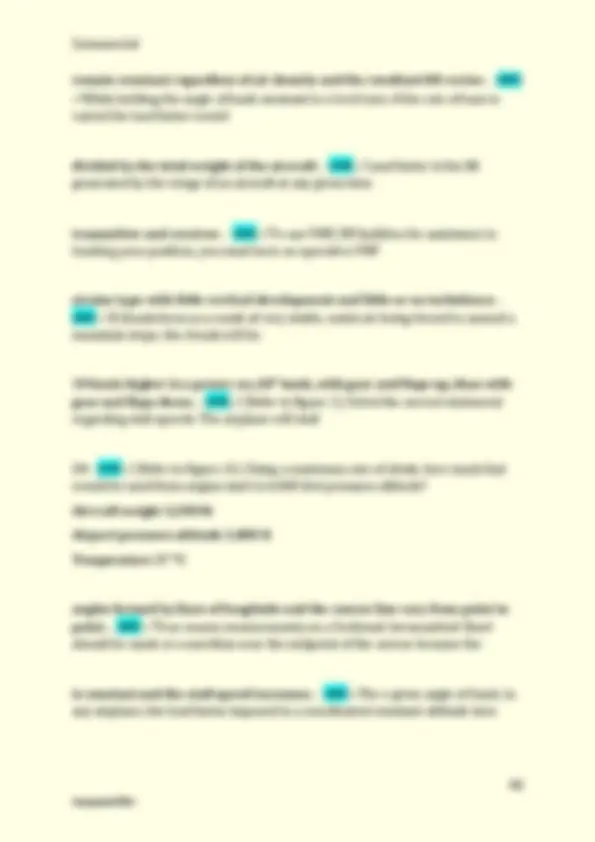
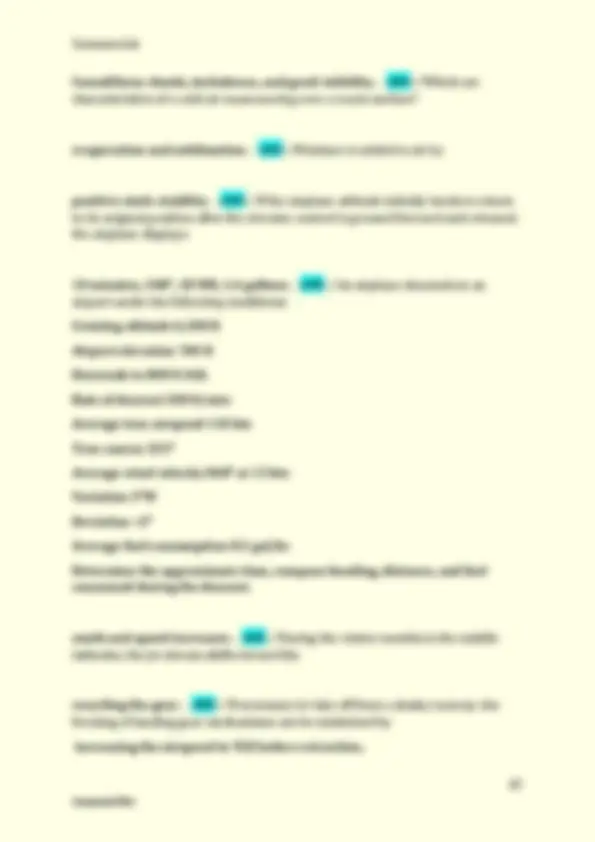
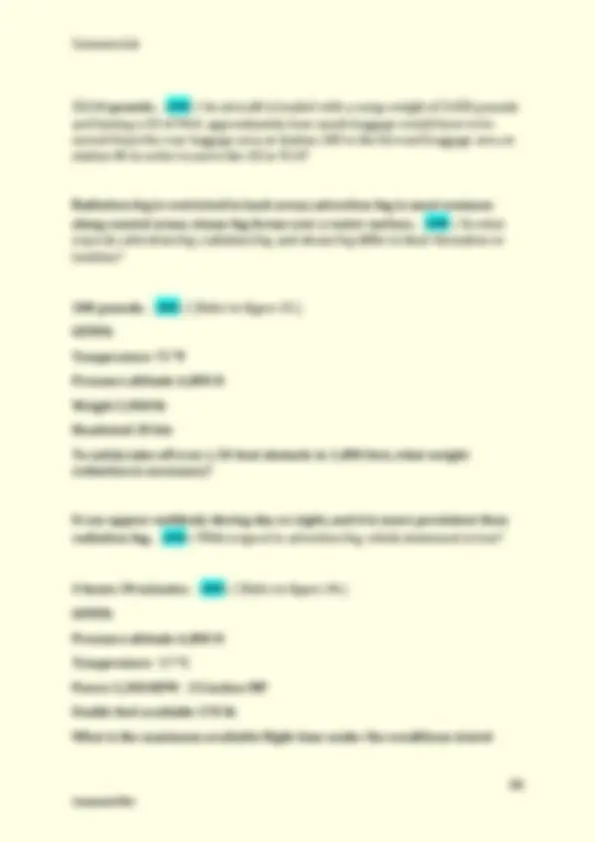
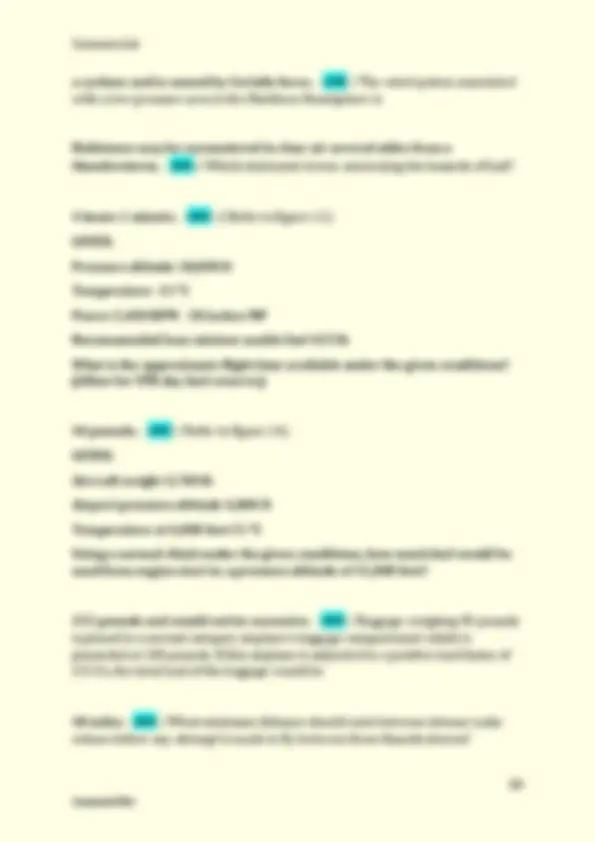
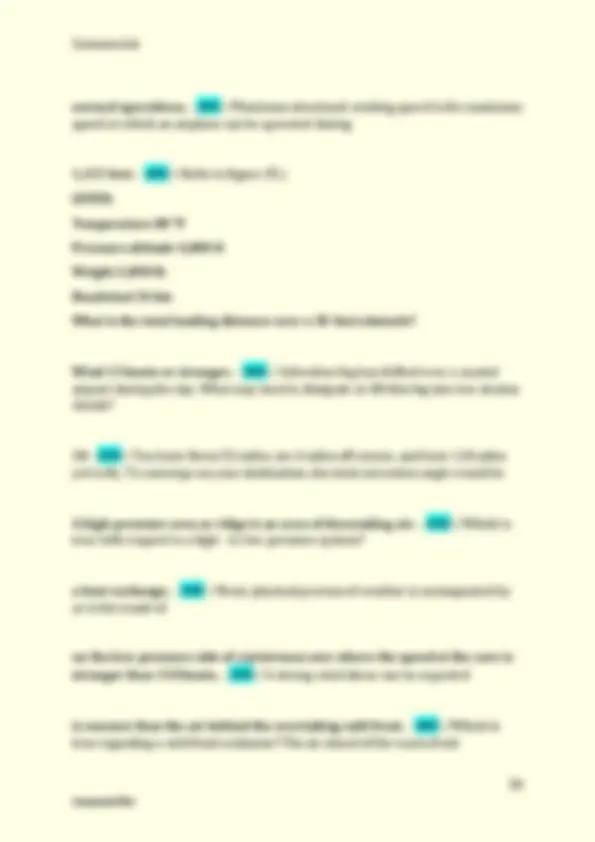


Study with the several resources on Docsity

Earn points by helping other students or get them with a premium plan


Prepare for your exams
Study with the several resources on Docsity

Earn points to download
Earn points by helping other students or get them with a premium plan
Community
Ask the community for help and clear up your study doubts
Discover the best universities in your country according to Docsity users
Free resources
Download our free guides on studying techniques, anxiety management strategies, and thesis advice from Docsity tutors
Regulations which refer to "operate" relate to that person who A.) is the sole manipulator of the aircraft controls. B.) acts as pilot in command of the aircraft. C.) causes the aircraft to be used or authorizes its use. - ANS ✓C.) causes the aircraft to be used or authorizes its use. Regulations which refer to the "operational control" of a flight are in relation to A.) the specific duties of any required crewmember. B.) exercising authority over initiating, conducting, or terminating a flight. C.) acting as the sole manipulator of the aircraft controls. - ANS ✓B.) exercising authority over initiating, conducting, or terminating a flight. Which is the correct symbol for the stalling speed or the minimum steady flight speed in a specified configuration?
Typology: Exams
1 / 50

This page cannot be seen from the preview
Don't miss anything!











































Regulations which refer to "operate" relate to that person who A.) is the sole manipulator of the aircraft controls. B.) acts as pilot in command of the aircraft. C.) causes the aircraft to be used or authorizes its use. - ANS ✓C.) causes the aircraft to be used or authorizes its use. Regulations which refer to the "operational control" of a flight are in relation to A.) the specific duties of any required crewmember. B.) exercising authority over initiating, conducting, or terminating a flight. C.) acting as the sole manipulator of the aircraft controls. - ANS ✓B.) exercising authority over initiating, conducting, or terminating a flight. Which is the correct symbol for the stalling speed or the minimum steady flight speed in a specified configuration? A.) VS0. B.) VS. C.) VS1. - ANS ✓C.) VS1. Which is the correct symbol for the stalling speed or the minimum steady flight speed at which the airplane is controllable?
14 CFR part 1 defines V[subscript F] as A.) flap operating speed. B.) maximum flap extended speed. C.) design flap speed. - ANS ✓C.) design flap speed. 14 CFR part 1 defines V[subscript NO] as A.) maximum operating speed. B.) maximum structural cruising speed. C.) normal operating speed. - ANS ✓B.) maximum structural cruising speed. 14 CFR part 1 defines V[subscript LE] as A.) maximum leading edge flaps extended speed. B.) maximum landing gear operating speed. C.) maximum landing gear extended speed. - ANS ✓C.) maximum landing gear extended speed. 14 CFR part 1 defines V[subscript NE] as A.) never-exceed speed. B.) maximum nose wheel extend speed. C.) maximum landing gear extended speed. - ANS ✓A.) never-exceed speed. 14 CFR part 1 defines V[subscript Y] as A.) speed for best angle of climb. B.) speed for best rate of climb.
A second-class medical certificate issued to a commercial pilot on April 10, this year, permits the pilot to exercise which of the following privileges? A.) Commercial pilot privileges through April 10, 2 years later. B.) Commercial pilot privileges through April 30, next year. C.) Private pilot privileges through, but not after, March 31, next year. - ANS ✓B.) Commercial pilot privileges through April 30, next year. When is the pilot in command required to hold a category and class rating appropriate to the aircraft being flown? A.) All solo flights. B.) On practical tests given by an examiner or FAA Inspector. C.) On flights when carrying another person. - ANS ✓C.) On flights when carrying another person. Unless otherwise authorized, the pilot in command is required to hold a type rating when operating any A.) aircraft that is certificated for more than one pilot. B.) aircraft of more than 12,500 pounds maximum certificated takeoff weight. C.) multiengine airplane having a gross weight of more than 12,000 pounds.
What flight time may a pilot log as second in command? A.) Only that flight time during which the second in command is the sole manipulator of the controls. B.) All flight time while acting as second in command in aircraft configured for more than one pilot. C.) All flight time when qualified and occupying a crewmember station in an aircraft that requires more than one pilot. - ANS ✓C.) All flight time when qualified and occupying a crewmember station in an aircraft that requires more than one pilot. What flight time must be documented and recorded by a pilot exercising the privileges of a commercial certificate? A.) Flight time showing training and aeronautical experience to meet requirements for a certificate, rating or flight review. B.) Only flight time for compensation or hire with passengers aboard which is necessary to meet the recent flight experience requirements. C.) All flight time flown for compensation or hire. - ANS ✓A.) Flight time showing training and aeronautical experience to meet requirements for a certificate, rating or flight review. If a pilot does not meet the recency of experience requirements for night flight and official sunset is 1900 CST, the latest time passengers should be carried is A.) 1800 CST. B.) 1900 CST. C.) 1959 CST. - ANS ✓C.) 1959 CST. Prior to carrying passengers at night, the pilot in command must have accomplished the required takeoffs and landings in A.) any category aircraft. B.) the same category and class of aircraft to be used.
A.) a logbook record of having made at least three flights as sole manipulator of the controls of a glider being towed by an airplane. B.) at least a private pilot certificate with a category rating for powered aircraft, and made and logged at least three flights as pilot or observer in a glider being towed by an airplane. C.) a logbook endorsement from an authorized glider instructor certifying receipt of ground and flight training in gliders, and be proficient with techniques and procedures for safe towing of gliders. - ANS ✓C.) a logbook endorsement from an authorized glider instructor certifying receipt of ground and flight training in gliders, and be proficient with techniques and procedures for safe towing of gliders. To act as pilot in command of an airplane towing a glider, a pilot must have accomplished, within the preceding 12 moths, at least A.) three actual or simulated glider tows while accompanied by a qualified tow pilot. B.) ten flights as pilot in command of an aircraft while towing a glider. C.) three actual glider tows under the supervision of a qualified tow pilot. - ANS ✓A.) three actual or simulated glider tows while accompanied by a qualified tow pilot. What limitation is imposed on a newly certificated commercial pilot - airplane, if that person does not hold an instrument rating? The carriage of passengers A.) or property for hire on cross-country flights at night is limited to a radius of 50 NM. B.) for fire on cross-country flights is limited to 50 NM for night flights, but not limited for day flights. C.) for hire on cross-country flights in excess of 50 NM, or for hire at night is prohibited. - ANS ✓C.) for hire on cross-country flights in excess of 50 NM, or for hire at night is prohibited. What is the maximum amount of flight instruction an authorized instructor may give in any 24 consecutive hours?
A.) 6 hours. B.) 4 hours. C.) 8 hours. - ANS ✓C.) 8 hours. Excluding Hawaii, the vertical limits of the Federal Low Altitude airways extend from A.) 700 feet AGL up to, but not including, 14,500 feet MSL. B.) 1,200 feet AGL up to, but not including, 18,000 feet MSL. C.) 1,200 feet AGL up to, but not including, 14,500 feet MSL. - ANS ✓B.) 1, feet AGL up to, but not including, 18,000 feet MSL. What action must be taken when a pilot in command deviates from any rule in 14 CFR part 91? A.) Upon landing, report the deviation to the nearest FAA Flight Standards District Office. B.) Upon the request of the Administrator, send a written report of that deviation to the Administrator. C.) Advise ATC of the pilot in command's intentions. - ANS ✓B.) Upon the request of the Administrator, send a written report of that deviation to the Administrator. Who is responsible for determining if an aircraft is in condition for safe flight? A.) The owner or operator. B.) The pilot in command. C.) A certificated aircraft mechanic. - ANS ✓B.) The pilot in command. When operating a U.S-registered civil aircraft, which document is required by regulation to be available in the aircraft? A.) A current, approved Airplane Flight Manual. B.) A manufacturer's Operations Manual.
A.) be familiar with the runway lengths at airports of intended use, and the alternatives available, if the flight cannot be completed. B.) list an alternate airport on the flight plan, and confirm adequate takeoff and landing performance at the destination airport. C.) be familiar with all instrument approaches at the destination airport. - ANS ✓A.) be familiar with the runway lengths at airports of intended use, and the alternatives available, if the flight cannot be completed. Before beginning any flight under IFR, the pilot in command must become familiar with all available information concerning that flight. In addition, the pilot must A.) list an alternate airport on the flight plan, and confirm adequate takeoff and landing performance at the destination airport. B.) be familiar with the runway lengths at airports of intended use, weather reports, fuel requirements, and alternatives available, if the planned flight cannot be completed. C.) be familiar with all instrument approaches at the destination airport. - ANS ✓B.) be familiar with the runway lengths at airports of intended use, weather reports, fuel requirements, and alternatives available, if the planned flight cannot be completed. Required flight crewmembers' safety belts must be fastened A.) only during takeoff and landing when passengers are aboard the aircraft. B.) while the crewmembers are at their stations. C.) only during takeoff and landing. - ANS ✓B.) while the crew members are at their stations. Each required flight crewmember is required to keep his or her shoulder harness fastened A.) during takeoff and landing, unless he or she is unable to perform required duties. B.) while the crewmembers are at their stations, unless he or she is unable to perform required duties.
C.) during takeoff and landing only when passengers are aboard the aircraft. - ANS ✓A.) during takeoff and landing, unless he or she is unable to perform required duties. With U.S.-registered civil airplanes, the use of safety belts is required during movement on the surface, takeoffs, and landings for A.) each person over 2 years of age on board. B.) safe operating practice, but not required by regulations. C.) commercial passenger operations only. - ANS ✓A.) each person over 2 years of age on board. Which is required to operate an aircraft towing an advertising banner? A.) Approval from ATC to operate in Class E airspace. B.) A certificate of waiver issued by the Administrator. C.) A safety link at each end of the towline which has a breaking strength not less than 80 percent of the aircraft's gross weight. - ANS ✓B.) A certificate of waiver issued by the Administrator. Portable electronic devices which may cause interference with the navigation or communication system may not be operated on a U.S.- registered civil aircraft being flown A.) in air carrier operations. B.) within the U.S. C.) along Federal airways. - ANS ✓A.) in air carrier operations. Portable electronic devices which may cause interference with the navigation or communication system may not be operated on U.S.- registered civil aircraft being flown A.) under IFR. B.) in passenger carrying operations C.) along Federal airways. - ANS ✓A.) under IFR.
In accordance with 14 CFR part 91, supplemental oxygen must be used by the required minimum flight crew for that time exceeding 30 minutes while at cabin pressure altitudes of A.) 12,000 feet MSL up to and including 18,000 feet MSL. B.) 12,500 feet MSL up to and including 14,000 feet MSL. C.) 10,500 feet MSL up to and including 12,500 feet MSL. - ANS ✓B.) 12, feet MSL up to and including 14,000 feet MSL. What are the oxygen requirements when operating at cabin pressure altitudes above 15,000 feet MSL? A.) Oxygen is not required at any altitude in a balloon. B.) The flightcrew and passengers must be provided with supplemental oxygen. C.) Oxygen must be available for the flightcrew. - ANS ✓B.) The flightcrew and passengers must be provided with supplemental oxygen. Which is required equipment for powered aircraft during VFR night flights? A.) Gyroscopic direction indicator. B.) Gyroscopic bank-and-pitch indicator. C.) Anticollision light system. - ANS ✓C.) Anticollision light system. Which is required equipment for powered aircraft during VFR night flights? A.) Flashlight with red lens, if the flight is for hire. B.) Sensitive altimeter adjustable for barometric pressure. C.) An electric landing light, if the flight is for hire. - ANS ✓C.) An electric landing light, if the flight is for hire. Approved flotation gear, readily available to each occupant, is required on each airplane if it is being flown for hire over water, A.) beyond power-off gliding distance from shore. B.) more than 50 statue miles from shore.
C.) in amphibious aircraft beyond 50 NM from shore. - ANS ✓A.) beyond power-off gliding distance from shore. Approved flotation gear, readily available to each occupant, is required on each airplane if it is being flown for hire over water, A.) in amphibious aircraft beyond 50 NM from shore. B.) more than 50 statue miles from shore. C.) beyond power-off gliding distance from shore. - ANS ✓C.) beyond power- off gliding distance from shore. Which is true with respect to operating limitations of a "restricted" category airplane? A.) A pilot of a "restricted" category airplane is required to hold a commercial pilot certificate. B.) A "restricted" category airplane is limited to an operating radius of 25 miles from its home base. C.) No person may operate a "restricted" category airplane carrying passengers or property for compensation or hire. - ANS ✓C.) No person may operate a "restricted" category airplane carrying passengers or property for compensation or hire. Which is true with respect to operating limitations of a "primary" category airplane? A.) A "primary" category airplane is limited to a specific operating radius from its home base. B.) No person may operate a "primary" category airplane carrying passengers or property for compensation or hire. C.) A pilot of a "primary" category airplane must hold a commercial pilot certificate when carrying passengers for compensation or hire. - ANS ✓B.) No person may operate a "primary" category airplane carrying passengers or property for compensation or hire. The carriage of passengers for hire by a commercial pilot is
C.) authorized when carrying passengers for hire, with prior arrangement with the pilot in command of each aircraft in the formation. - ANS ✓A.) not authorized when carrying passengers for hire. Which is true with respect to operating near other aircraft in flight? They are A.) not authorized, unless the pilot in command of each aircraft is trained and found competent in formation. B.) authorized when carry passengers for hire, with prior arrangement with the pilot in command of each aircraft in the formation. C.) not authorized, when operated so close to another aircraft they can create a collision hazard. - ANS ✓C.) not authorized, when operated so close to another aircraft they can create a collision hazard. Which is true with respect to formation flights? Formation flights are A.) authorized when carrying passengers for hire, with prior arrangement with the pilot in command of each aircraft in the formation. B.) not authorized, except by arrangement with the pilot in command of each aircraft. C.) not authorized, unless the pilot in command of each aircraft is trained and found competent in formation. - ANS ✓B.) not authorized, except by arrangement with the pilot in command of each aircraft. While in flight a helicopter and an airplane are converging at a 90 degree angle, and the helicopter is located to the right of the airplane. Which aircraft has the right-of-way over helicopters? A.) The airplane, because airplanes have the right-of-way over helicopters. B.) The helicopter, because it is to the right of the airplane. C.) The helicopter, because helicopters have the right-of-way over airplanes. - ANS ✓B.) The helicopter, because it is to the right of the airplane. Two aircraft of the same category are approaching an airport for the purpose of landing. The right-of-way belongs to the aircraft
A.) that is more maneuverable, and that aircraft may, with caution, move in front of or overtake the other aircraft. B.) at the higher altitude. C.) at the lower altitude, but the pilot shall not take advantage of this rule to cut in front of or to overtake the other aircraft. - ANS ✓C.) at the lower altitude, but the pilot shall not take advantage of this rule to cut in front of or to overtake the other aircraft. During a night operation, the pilot of aircraft #1 sees only the green light of aircraft #2. If the aircraft are converging, which pilot has the right-of-way? The pilot of aircraft A.) #2; aircraft #2 is to the right of aircraft #1. B.) #1; aircraft #1 is to the right of aircraft #2. C.) #2; aircraft #2 is to the left of aircraft #1. - ANS ✓B.) #1; aircraft #1 is to the right of aircraft #2. A pilot flying a single-engine airplane observes a multiengine airplane approaching from the left. Which pilot should give way? A.) The pilot of the multiengine airplane should give way; the single-engine airplane is to its right. B.) Each pilot should alter course to the right. C.) The pilot of the single-engine airplane should give way; the other airplane is to the left. - ANS ✓A.) The pilot of the multiengine airplane should give way; the single-ensine airplane is to its right. Airplane A is overtaking airplane B. Which airplane has the right-of-way? A.) Airplane B; the pilot should expect to be passed on the right. B.) Airplane B; the pilot should expect to the passed on the left. C.) Airplane A; the pilot should alter course to the right to pass. - ANS ✓A.) Airplane B; the pilot should expect to be passed on the right. An airplane is overtaking a helicopter. Which aircraft has the right-of-way?
If an aircraft is not equipped with an electrical or anti collision light system, no person may operate that aircraft A.) 1 hour after sunset. B.) after dark. C.) after sunset to sunrise. - ANS ✓C.) after sunset to sunrise. Which is true regarding flight operations in Class C airspace? A.) Solo student pilot operations are not authorized. B.) The pilot must receive ATC clearance before operating an aircraft in that area. C.) Flight under VFR is not authorized unless the pilot in command in instrument rated. - ANS ✓B.) The pilot must receive ATC clearance before operating an aircraft in that area. Which is true regarding pilot certification requirements for operations in Class B airspace? A.) The pilot in command must hold at least a private pilot certificate with an instrument rating. B.) The pilot in command must hold at least a private pilot certificate. C.) Solo student pilot operations are not authorized. - ANS ✓B.) The pilot in command must hold at least a private pilot certificate. Which is true regarding flight operations in Class B airspace? A.) The pilot in command must hold at least a private pilot certificate with an instrument rating. B.) The pilot in command must hold at least a student pilot certificate. C.) The aircraft must be equipped with an ATC transponder and altitude reporting equipment. - ANS ✓C.) The aircraft must be equipped with an ATC transponder and altitude reporting equipment. The minimum flight visibility for VFR flight increases to 5 statute miles beginning at an altitude of
A.) 10,000 feet MSL regardless of height above ground. B.) 10,000 feet MSL if above 1,200 feet AGL. C.) 14,500 feet MSL. - ANS ✓B.) 10,000 feet MSL if above 1,200 feet AGL. What is the minimum flight visibility and proximity to cloud requirements for VFR flight, at 6,500 feet MSL, in Class C,D, and E, airspace? A.) 1 mile visibility; clear of clouds. B.) 5 miles visibility; 1,000 feet above and 1,000 feet below. C.) 3 miles visibility; 1,000 feet above and 500 feet below. - ANS ✓C.) 3 miles visibility; 1,000 feet above and 500 feet below. Which minimum flight visibility and distance from clouds is required for a day VFR helicopter flight in Class G airspace at 3,500 feet MSL over terrain with an elevation of 1,900 feet MSL? A.) Visibility-1 miles; distance from clouds-500 feet below, 1,000 feet above, and 2,000 feet horizontally. B.) Visibility-3 miles; distance from clouds-1,000 feet below, 1,000 feet above, and 1 miles horizontally. C.) Visibility-3 miles; distance from clouds-500 feet below, 1,000 feet above, and 2,000 feet horizontally. - ANS ✓A.) Visibility- 1 miles; distance from clouds- 500 feet below, 1,000 feet above, and 2,000 feet horizontally. Basic VFR weather minimums require at least what visibility for operating a helicopter within Class D airspace? A.) 3 miles. B.) 2 miles. C.) 1 mile. - ANS ✓A.) 3 miles. When operating an airplane for the purpose of takeoff or landing within Class D airspace under special VFR, what minimum distance from clouds and what visibility are required? A.) Remain clear of clouds, and the ground visibility must be at least 1 SM.